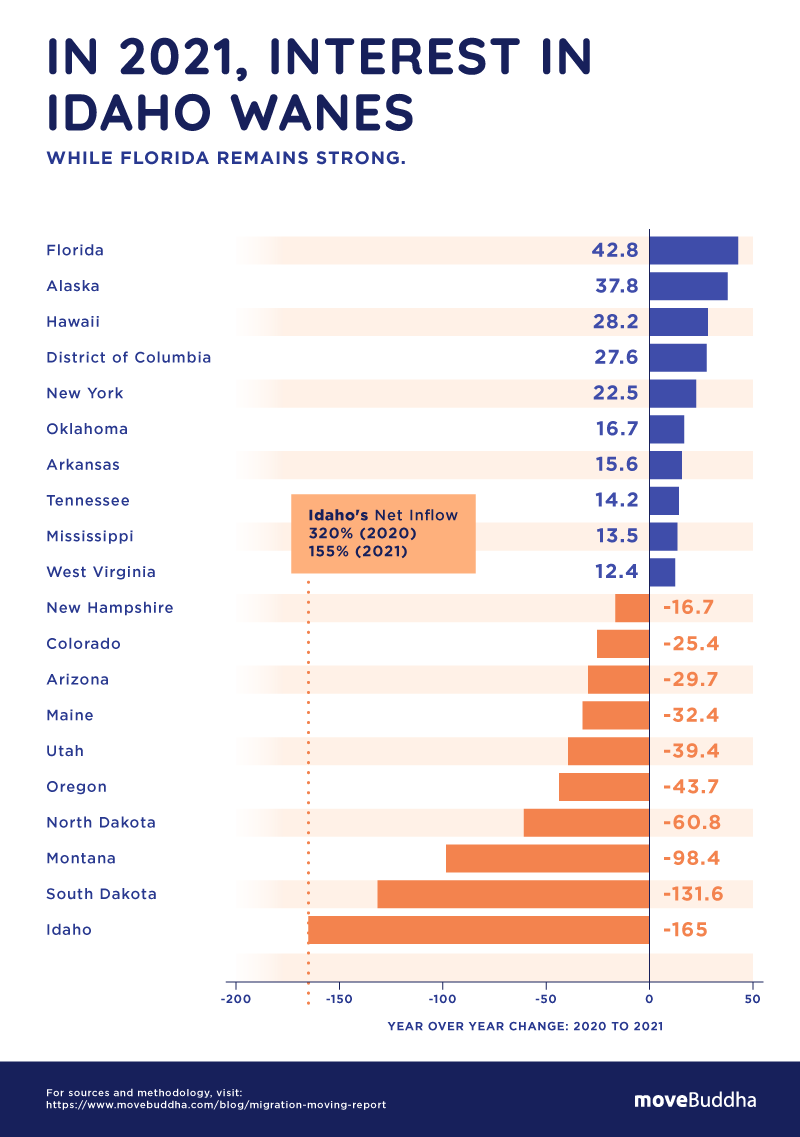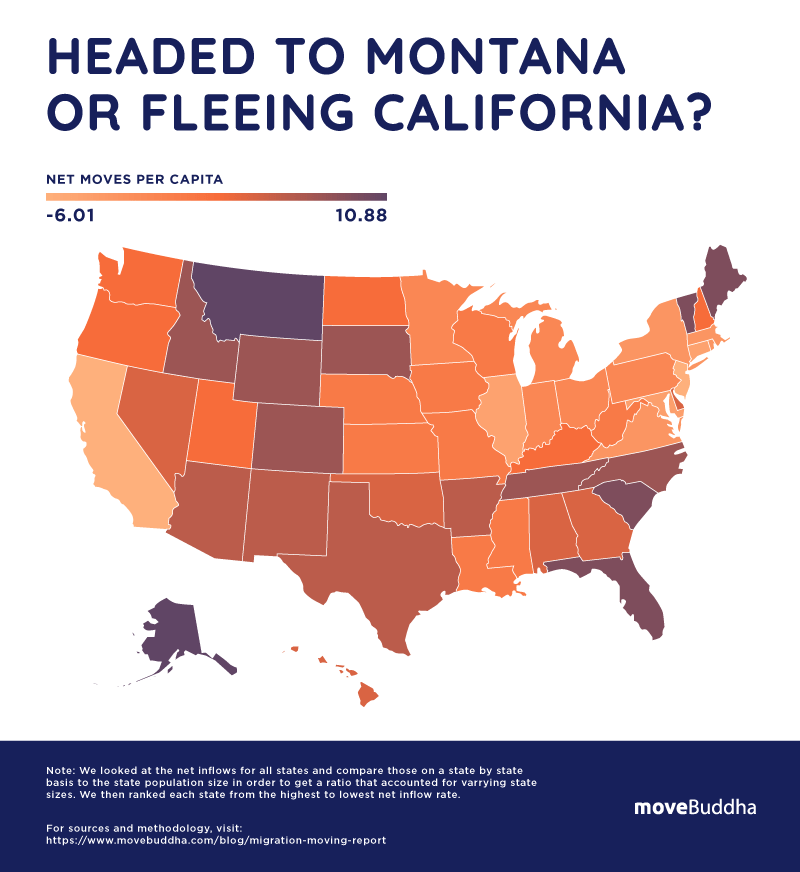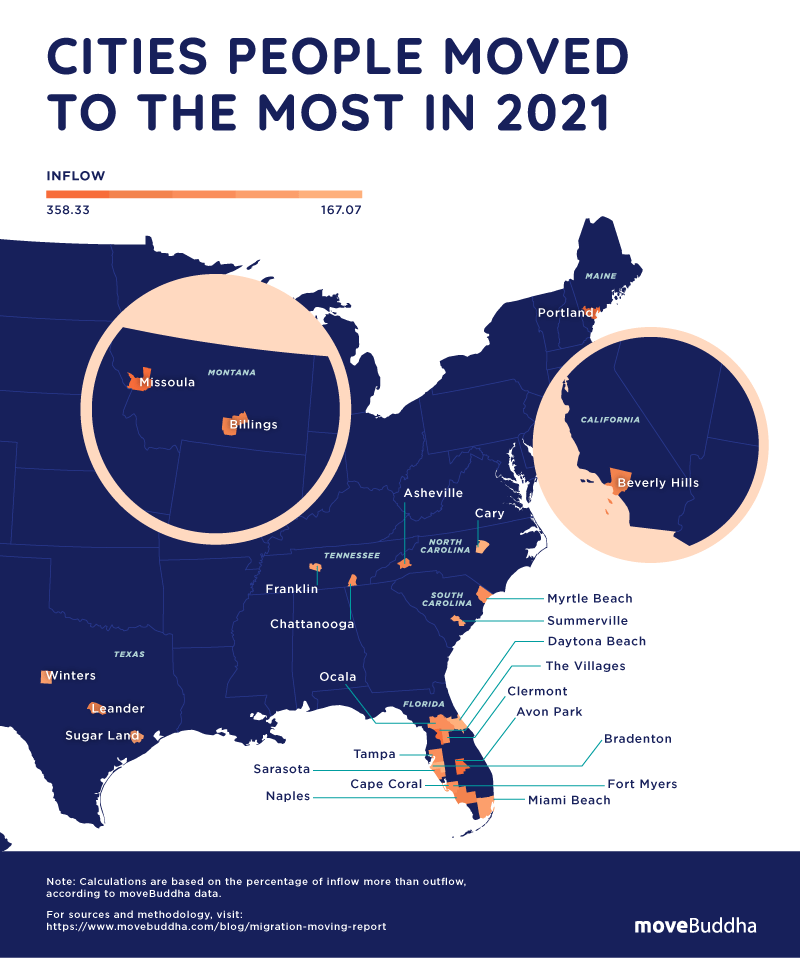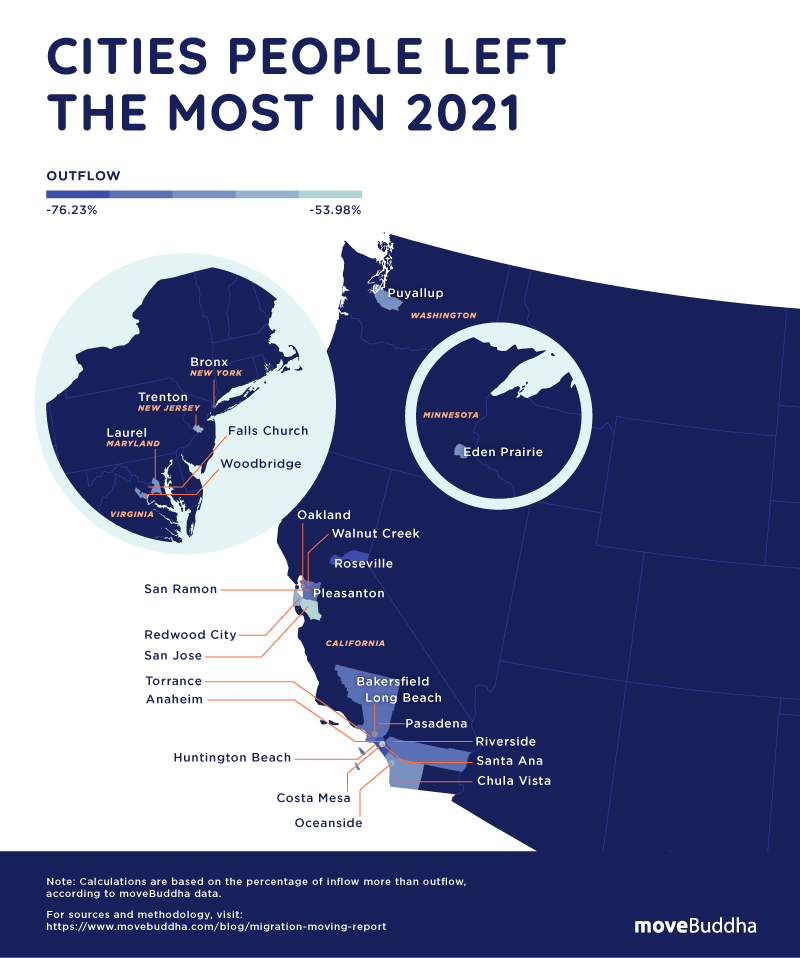Unsettled State: The moveBuddha 2021 Migration Report
Only 8.4% of Americans (27 million) reported moving this year making 2021 the lowest mover rate in over 70 years. However, long-distance, state-to-state moves saw an increase according to new census data.
We crunched the numbers on more than 400,000 relocation queries in 2021 to gain a better picture of the new normal in domestic migration.
Key Findings
- Florida saw a sharp rise in net migration flow in 2021. The ratio of inbound to outbound moves jumped 43 percentage points from 2020 to 2021, meaning more than twice as many people moved into Florida than left it.
- Moves into Idaho are leveling off compared to last year. Where inbound moves outnumbered outbound moves 3 to 1 in 2020, this year the ratio was 1.5 to 1.
- Mass migrations out of California continue, other states seeing high rates of outflow include New Jersey, Illinois, and Connecticut. On the flip side, the state showing the highest rate of inflow vs. outflow was Montana, with 73% of total moves coming in.
- In 2021, Montana had the highest net inflow of moves per capita, with 73% of moves inbound. Billings was the #1 destination with a 3.9 to 1 inbound to outbound ratio.
- Small interstate moves (consisting of one small bedroom or less) were down 10% in 2021 compared to 2020, while every category of larger interstate moves grew.
- When people move out of big cities, they tend to move to other, large cities. Among the 30 most populous American cities, departing residents relocated to cities that were, on average, 30% larger than where they were coming from.
I. Relocating in a pandemic: How COVID-19 continues to impact moving trends in America
The coronavirus pandemic has made for a great deal of turbulence in our home lives, and this has certainly been reflected in domestic moving trends. Here is a quick bird’s eye view of American migration patterns since March 2020.
A dramatic stop and a hasty recovery: Moving amidst a pandemic
The Pew Research Center reported that March 2020 to March 2021 was the slowest year on record for domestic moves, with only 8% of Americans changing residences during this period of lockdowns, joblessness, and mass hospitalizations.
But by the second quarter of 2021, Americans were revving to go forward with moving plans they had put on pause during the beginning of the pandemic. After a year spent working from home, many people began to reconsider their location and the size of their living space.
In our August 2021 survey, more than 13% of Americans reported having moved since March 2020. Furthermore, more than a third of these people cited concerns about COVID-19 or the ability to work from home as a driving motivation for relocating.
Summer 2021 a logistical nightmare for the moving industry
Summers are peak season for the moving industry, with as much as 70% of relocations each year taking place between May and August. But the summer of 2021 ushered in a moving apocalypse, during which unprecedented demand for moving services was met with an industry-wide shortage of workers and logistical headaches.
In our survey of 63 long-distance moving companies, nearly half reported being booked out at least three weeks further than in previous seasons. The labor shortage spurred by COVID-19 played a major role in these delays, with 63% of moving companies reporting they couldn’t hire enough drivers, and 43% reporting they were understaffed for other roles as well.
Additionally, some 8% of moving companies cited the difficulties of navigating the varying COVID-related health and safety regulations from state to state as another challenge facing their business in 2021.
II. State of Flux: Comparing interstate moves between 2020 and 2021
Which states gained the most new residents, and which lost the most to migration? We looked into interstate moving data to see which trends from 2020 continued in 2021, and which trends were bucked.
The following graph shows how the percentage change** of inbound to outbound moves by state has grown or shrunken between 2020 and 2021. (Interactive version here.)
Explosive growth in Florida and Alaska
In 2020, the Sunshine State saw 167% more inbound than outbound moves, making it one of the country’s most popular destinations for movers. This figure exploded in 2021, jumping 42.8% with a total volume of inbound moves more than twice that of outbound moves at 210%. This means that in 2021 for every 100 moves out, 210 were coming in.
What might account for the tremendous uptick in moves to Florida? An analysis by the New School shows that in 2021, 2 million more people than originally projected retired. As we’ll see in Section IV, Florida cities with especially high concentrations of retirees were some of the fastest-growing cities in terms of net migration in 2021.
On the literal opposite side of the country, Alaska is also seeing a spike in residential growth. In 2020, we processed 68% more moving requests into Alaska than out. And in 2021, this number climbed by 38 percentage points, the second largest growth of any state.
The flow to Idaho levels off
Over the past few years, there has been a growing buzz about Idaho. Five cities in the Gem State appeared on our list of 2020’s Fastest Growing Mid-Size Cities, and home prices in the capital and most populous city Boise are rising more sharply than anywhere else in the country.
Make no doubt about it: Idaho is growing. We processed 55% more moves to Idaho than out of Idaho in 2021. But this is a significantly smaller difference than in 2020 when inbound Idaho moves outnumbered outbound moves by more than 3 to 1. The negative net migration percentage change** suggests that the influx of people heading to Idaho may be stabilizing a bit.
Is the mass exodus from New York cooling down?
In 2020, New York was among the most popular places to flee; for every move into New York, we processed two for people wishing to leave. While 2021 wasn’t an overall win for New York in terms of residents gained through migration, the state is among our winners for the most improved. Though still losing more residents to migration than gaining them, New York’s net migration ratio* improved by 22.5 percentage points in 2021.
III. Which states did people migrate to in 2021?
Looking purely at the top and bottom net inflows from 2021 we would see states with the highest populations at the top of the list and lower populated states at the bottom. But we wanted to know where fresh arrivals are most likely making their presence felt.
So, in order to better understand in which states are people most likely to notice a wave of new neighbors, we compared the volume of net inbound moves for each state with that state’s population***.
The following map shows which state saw the greatest proportion of net migration relative to the population (dark blue), as well as the states that saw the least (pale orange). (Interactive version here.)
Into the wild north
Many of the states with the highest proportion of net migrations relative to the population are located at comparatively high latitudes. Montana (#1), Alaska (#2), Maine (#3), and Vermont (#5) are known for their rustic views, open spaces, and bitterly cold winters. As the pandemic has taught us to value distance from other people in a way we may not have previously, these less densely populated states may have become increasingly appealing in 2021.
Less propensity for density
Speaking of population density…after California, New Jersey lost the greatest number of residents to migration relative to its population. New Jersey is America’s most densely populated state (after Washington, D.C.). Other especially dense states also appear at the bottom of this ranking, including Connecticut (#48 of 51), Maryland (#47), and Rhode Island (#46).
IV. Which cities were more popular in 2021 than 2020?
Which cities proved to be the flavor of the year for those who moved in 2021? And which cities lost the greatest number of residents to migration? We looked into city moving data to see which cities saw notable changes in migration patterns between 2020 and 2021.
The following interactive charts show which cities saw the most growth in net migration between 2020 and 2021, and the steepest decline.
Year-to-year decline, but still doing fine
While the 25 cities with the steepest decline in year-over-year net migration did see fewer inbound moves relative to outbound ones in 2021, only 10 of the 25 dipped into negative territory (inbound/outbound ratio less than 1.0). The remaining 15 still saw a greater number of inbound than outbound moves, and for many these numbers represent sustained population growth, despite having slowed down since 2020.
Flocking to Florida
As shown in our state-by-state data analysis, Florida saw a large uptick in migration compared to last year. Of the top 25 cities with the greatest net migration growth between 2020 and 2021, thirteen of them are located in Florida.
These include popular retirement destinations such as The Villages (#2), Fort Myers (#4), Naples (#11), Tampa (#17), and Port Saint Lucie (21), lending further credence to the theory that spontaneous retirement is partly responsible for the growing interest in moving to Florida.
Mid-size and mighty
With a few exceptions, the majority of the top 25 cities with the most growth in net migration are comfortably mid-size, with populations ranging from 10k to 200k residents. Among the top 25, the average population (when New York City is excluded) amounts to 130k, compared to a significantly larger overall list average of 294k, and a bottom-25-average of 177k.
Is Billings the new Missoula?
In 2020, Missoula, MT had the highest rate of net migration in the country, with more than seven times the inbound vs outbound moves. In 2021, Missoula is still going strong with nearly four times more inbound than outbound moves. But this is the single, sharpest decline in net migration in our analysis.
Another Montana city may be emerging as a new boomtown, however. Billings, MT rapidly ascended from 2.7x the inbound vs outbound moves in 2020, to 3.9x the inbound moves in 2021. Will Billings surpass Missoula in 2022?
V. Migration in major metropoles: Which big cities were more popular in 2021?
With so much discussion of people abandoning large cities in droves and moving out to the suburbs or the countryside, we knew we wanted to analyze migration patterns in and out of America’s largest cities.
Are big cities really losing more residents than they are gaining?
The following interactive chart shows which major cities (population 250k and up) saw the greatest spike in net migration between 2020 and 2021:
New York City’s comeback
During the first year of the pandemic, the Big Apple saw nearly twice as many outbound as inbound moves as people fled one of the worst-affected regions for places with more space and a more affordable cost of living.
But as of 2021, New York is recovering its reputation as the place where everyone who is anyone wants to be. New York’s ratio of inbound to outbound moves climbed by 85 percentage points, thereby achieving a positive net migration count this year.
San Francisco still hemorrhaging residents
San Francisco was another major city for whose weary residents the pandemic was the final straw. In 2020, we processed at least two outbound moves for every inbound move to San Francisco.
San Francisco didn’t see the comeback that NYC did, however. While net migration in the Golden Gate City did improve significantly in 2021, the city still lost three residents for every two that it gained.
“I lived there before it was cool.”
There are a number of major cities that have sustained high rates of net migration between 2020 and 2021, but for whom 2021 indicates that growth may be slowing.
Notable cities in this category include hyped hipster paradises like Austin, TX; Denver, CO; and Portland, OR. Though each of these cities has continued to grow in population since 2020, there also seem to be increasing rates of outbound migration from all of them.
Cities you’ll certainly be hearing more about
While the cities with million+ residents tend to hog the spotlight, some other cities are showing higher and higher rates of net inflow each year. The likes of Tampa, FL; Fort Worth, TX; Tulsa, OK; Anchorage, AK; and Miami, FL all had strong net migration in 2020, only to see even higher inflow rates in 2021.
VI. Where the people want to be (and where they don’t): Cities with the most and least inflow in 2021
We looked at the percentage of inflow more than outflow**** to determine which cities are preserving existing residents while attracting new ones, and which cities are losing residents faster than they can gain new ones.
Hot! Hot! Hot! Florida is on fire (in a good way!)
You know what they say: once you go Florida, you never go back.
Florida cities dominate among moving destinations with significantly higher inflow than outflow, with 12 placements among our top 25. From retirement communities such as The Villages to sexy, tech-forward cities like Miami, Floridian cities are booming.
(Click here for an interactive graph with more details.)
California is on fire (in a bad way!)
America’s most populous state may not stay that way too much longer. Between high costs of living, impossible housing markets, and natural disasters threatening public health, it is no wonder that 18 of the 25 cities with the lowest proportion of inbound vs outbound moves are located in California.
(Click here for an interactive graph with more details.)
VII. Move sizes and distances in 2021
How much stuff?
Inspiration from Mari Kondo’s Netflix special didn’t seem to outlast the pandemic. It’s not only the volume of moves that increased between 2020 and 2021; it’s also the amount of stuff people took with them.
Small interstate moves (consisting of one small bedroom or less) were down 10% in 2021 compared to 2020, while every category of larger interstate moves grew.
How far?
When residents move out of major cities, how far do they normally travel? We looked closer at the average distance for moves out of America’s 30 largest cities in 2021.
Our data suggests that, when West Coasters move, they leave the West Coast. The average distance for a 2021 move out of Los Angeles or San Francisco is between 1700 and 1800 miles, which is about the distance to the Mississippi River.
Southerners and Midwesterners, on the other hand, are more likely to stick to the same region. For instance, the average person leaving Fort Worth, TX travels 581 miles, which is only enough to get them as far as El Paso.
Leaving the big city for greener pastures?
Though plenty of headlines may suggest that people are leaving big cities in droves, our data shows that, for the most part, when residents of big cities move, they move to other big cities. For people who moved out of one of America’s 30 most populous cities in 2021, we looked at the populations of the cities where they relocated.
In 19 of 30 cases, average outbound residents settled in cities that were as large if not larger in population. In fact, in 11 out of 30 cases, the average destination city is at least 40% larger than the city they departed.
The only cities from which departing residents are likely to relocate to a significantly smaller city are San Diego, San Antonio, Chicago, Houston, Phoenix, and of course – New York City.
Sources & Methodology
This report uses moveBuddha proprietary data from January 1, 2020 through December 9, 2021 capturing searches by individuals who were either planning to move themselves or hire a moving company. Data included in this study is limited to U.S. domestic moves. Search data for 2021 alone amounts to over 400,000 individual queries.
For city-level analysis, we only included cities with a minimum of 50 inbound queries and 50 outbound queries.
For analysis that included population data, we relied on the U.S. Census. 2020 Census data was used in all cases, except for in the analysis of Move Sizes & Distances (Chapter VII), where we used 2019 population estimates.
Methodology
*Net migration ratio
The net migration ratio is the proportion of inbound vs. outbound moves for a city or state over the course of a calendar year.
Net migration ratio = inbound moves / outbound moves
Ratios >1 indicate more inflow than outflow.
Ratios <1 indicate more outflow than inflow.
Ex: New York City in 2020 had a net migration ratio of .50 (also expressed as 50) meaning that for every 50 inbound moves, 100 moved out. In 2021 that ratio increased to 1.4 (also expressed as 140) meaning that for every 140 inbound moves, 100 moved out.
**Ratio change: Year-over-year percentage change
Calculations based on year-to-year change in migration were derived using the net migration ratio. This same method has also been used by LinkedIn data scientists and Bloomberg.
A YoY percent change >0 indicates that there was an increase in the ratio of inflow from one year to the next.
A YoY percent change <0 indicates that there was a decrease in the ratio of inflow from one year to the next.
YoY % Change = 2021 Net Migration Ratio – 2020 Net Migration Ratio
NYC Example: 140 – 50 = 90
In this example, New York City’s net migration ratio improved 90 percentage points from 2020 to 2021.
***Net moves per capita:
State net inflow (inflow minus outflow) divided by the state population.
****Percentage of inflow more than outflow:
To understand the inflow as a comparison of outflow, this metric represents inflow in terms of what percentage it is greater than outflow.
Positive percentage indicates higher proportions of inflow, while negative indicates higher proportion of outflow.
For instance, if the percentage inflow more than outflow is 150%, and the outflow is 100, then inflow can be derived like so:
100 (the outflow) + (100*150%) = 250 (the inflow).
Not what you were looking for?
Check out other categories that can help you find the information you need!











